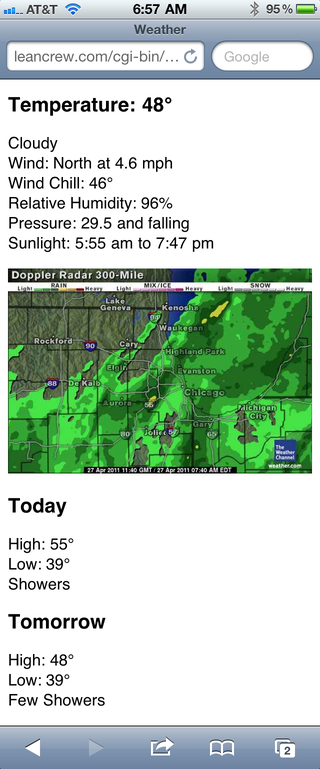Weather or not
April 26, 2011 at 10:26 PM by Dr. Drang
Ben Brooks spent all day publishing posts on iOS weather apps, and after reviewing over a dozen apps, he still didn’t find an unambiguous winner.
I feel his pain. I’ve tried a handful of weather apps—nothing that Ben didn’t cover today—and have kept switching back and forth because none of them have been satisfying. While reading Ben’s posts, I decided that most of the time all I really wanted in a weather app is what I have on my Mac desktop via NerdTool: a short text description of the current conditions and forecasts for today and tomorrow and a radar image of the Chicago area.
I decided to try a simple CGI script that uses the same pywapi Python library used by my weathertext script. In addition to the text, it grabs the radar image I use on my Desktop. The script is saved as weather.cgi in the weathertext repository, and you can see it in action by pointing Mobile Safari to http://leancrew.com/cgi-bin/weather.cgi.

Update 4/27/11
I should mention that I made a weather webapp
The best thing about weather.cgi is its speed. Because there’s only one image—and it’s a static image—the page loads much more quickly than any of the apps I’ve used.
Obviously, this is not a complete substitute for a real weather app because it’s limited to a single location. But it’s the location I spend the most time checking, so it may work better than a real app when I’m around home. I’ve put a link to it on my home screen so I can test it for a week or so.
Update 4/28/11
Young Mr. Brooks has forked my repository, changed the location to Seattle, and restyled the output by fiddling with the embedded CSS. You can see it here.
I think I’ll steal his idea of making the current temperature more prominent (and getting rid of the word “temperature”—what else would it be?), but I won’t be changing the font to Thornburi. Verdana maybe, but not Thornburi. And my old eyes could use a bit more contrast than he gives.
-
Yes, it’s pretentious to call a simple CGI script a webapp, but that’s the term most likely to be understood. ↩
